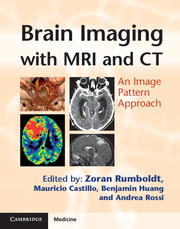Book contents
- Frontmatter
- Contents
- List of contributors
- List of abbreviations
- Preface
- Section 1 Bilateral Predominantly Symmetric Abnormalities
- Section 2 Sellar, Perisellar and Midline Lesions
- Section 3 Parenchymal Defects or Abnormal Volume
- Section 4 Abnormalities Without Significant Mass Effect
- Section 5 Primarily Extra-Axial Focal Space-Occupying Lesions
- Section 6 Primarily Intra-Axial Masses
- Section 7 Intracranial Calcifications
- 184 Congenital Cytomegalovirus Infection
- 185 Congenital Toxoplasmosis
- 186 Aicardi–Goutieres Syndrome
- 187 Physiologic Basal Ganglia Calcifications
- 188 Hyperparathyroidism
- 189 Meningioangiomatosis
- 190 Vascular Wall Calcification
- 191 Dystrophic Calcifications
- 192 Calcified Aneurysms
- 193 Vascular Malformations
- 194 Cysticercosis
- 195 Calcified Metastases
- 196 Ganglioglioma
- 197 Oligodendroglioma
- 198 Cortical Tubers in Tuberous Sclerosis
- 199 Subependymal Nodules in Tuberous Sclerosis
- 200 Ependymoma
- 201 Lipoma With Calcification
- 202 Craniopharyngioma
- 203 Meningioma
- 204 Teflon Granuloma
- Index
- References
188 - Hyperparathyroidism
from Section 7 - Intracranial Calcifications
Published online by Cambridge University Press: 05 August 2013
- Frontmatter
- Contents
- List of contributors
- List of abbreviations
- Preface
- Section 1 Bilateral Predominantly Symmetric Abnormalities
- Section 2 Sellar, Perisellar and Midline Lesions
- Section 3 Parenchymal Defects or Abnormal Volume
- Section 4 Abnormalities Without Significant Mass Effect
- Section 5 Primarily Extra-Axial Focal Space-Occupying Lesions
- Section 6 Primarily Intra-Axial Masses
- Section 7 Intracranial Calcifications
- 184 Congenital Cytomegalovirus Infection
- 185 Congenital Toxoplasmosis
- 186 Aicardi–Goutieres Syndrome
- 187 Physiologic Basal Ganglia Calcifications
- 188 Hyperparathyroidism
- 189 Meningioangiomatosis
- 190 Vascular Wall Calcification
- 191 Dystrophic Calcifications
- 192 Calcified Aneurysms
- 193 Vascular Malformations
- 194 Cysticercosis
- 195 Calcified Metastases
- 196 Ganglioglioma
- 197 Oligodendroglioma
- 198 Cortical Tubers in Tuberous Sclerosis
- 199 Subependymal Nodules in Tuberous Sclerosis
- 200 Ependymoma
- 201 Lipoma With Calcification
- 202 Craniopharyngioma
- 203 Meningioma
- 204 Teflon Granuloma
- Index
- References
Summary
Specific Imaging Findings
Intracranial calcifications from hyperparathyroidism are typically nodular and symmetric on CT, most commonly seen along dural surfaces, particularly the tentorium and falx. Parenchymal calcifications in the deep gray matter, subcortical regions, and cerebellar folia are frequently dense and bulky. Both parenchymal and dural calcifications can occur in isolation. Extracranial calcifications may be observed in corneas, sclerae, and salivary glands. The calcifications are of variable MR signal intensities, with parenchymal calcifications being frequently T1 hyperintense. T2*-weighted sequences demonstrate signal loss with blooming due to magnetic susceptibility.
Pertinent Clinical Information
Neurologic presentations are related to hypercalcemia and include weakness, fatigue, lethargy, depression, or cognitive impairment. Intracranial calcifications are primarily reported with secondary or tertiary hyperparathyroidism.
Differential Diagnosis
Physiologic Basal Ganglia Calcifications (187)
• typically localized to globus pallidus
• no dural involvement
Fahr Disease
• no dural involvement
• periventricular white matter may be affected
Hypoparathyroidism
• no dural involvement
Aicardi–Goutières Syndrome (186)
• also periventricular calcifications
• no dural involvement
• leukodystrophy with abnormal white matter and atrophy
• presents in infancy
Radiation/Chemotherapy-Induced Leukoencephalopathy (26, 190)
• CT hypodense and T2 hyperintense white matter
• calcifications primarily in the white matter
Information
- Type
- Chapter
- Information
- Brain Imaging with MRI and CTAn Image Pattern Approach, pp. 389 - 390Publisher: Cambridge University PressPrint publication year: 2012
